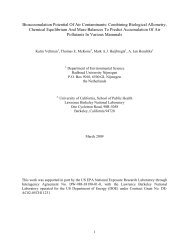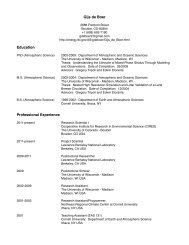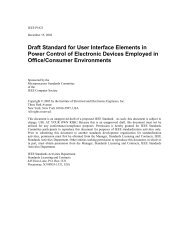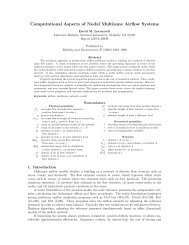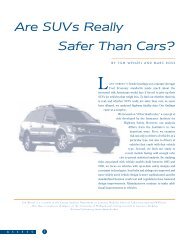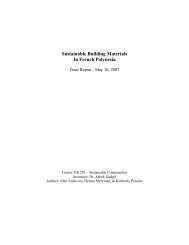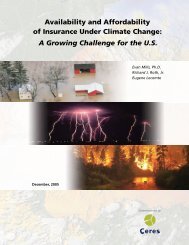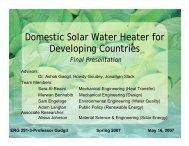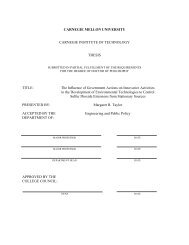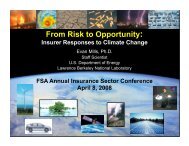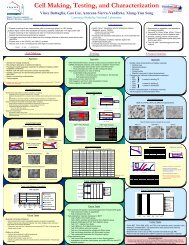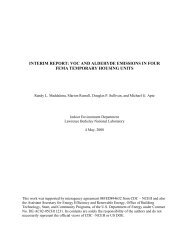Indoor Environment Department - Environmental Energy ...
Indoor Environment Department - Environmental Energy ...
Indoor Environment Department - Environmental Energy ...
Create successful ePaper yourself
Turn your PDF publications into a flip-book with our unique Google optimized e-Paper software.
•<br />
•<br />
•<br />
•<br />
•<br />
•<br />
•<br />
•<br />
•<br />
Examples of Achievement<br />
Examples of recent achievements of the <strong>Indoor</strong><br />
<strong>Environment</strong> <strong>Department</strong> are listed below.<br />
Characterized the relationship between rates of<br />
outdoor air supply to office buildings and the office<br />
worker’s health symptoms and work performance<br />
Quantified the relationship between dampness and<br />
mold in homes and prevalence of asthma and<br />
respiratory health effects<br />
Identified the opportunity to simultaneously<br />
improve comfort, health, and building energy<br />
performance through better control of air temperatures<br />
in offices<br />
Evaluated technologies for measuring and controlling<br />
office building ventilation rates, providing<br />
guidance for equipment selection<br />
Developed an improved method for measuring the<br />
rates of air leakage in residential duct systems<br />
Led the development of the first ASHRAE ventilation<br />
and indoor air quality standard for homes<br />
Quantified the emission rates of air pollutants from<br />
office equipment<br />
Evaluated the energy performance of residential air<br />
handling systems, leading to changes in fan<br />
efficiency specifications in California Title 24 codes<br />
and to the development of a new ASHRAE standard<br />
on residential air handler cabinet leakage<br />
Developed extensive technical guidance for the<br />
ongoing greening of the U.S. Capital Building<br />
Complex<br />
Contacts<br />
William Fisk<br />
Telelphone: 510-486-5910<br />
Email: WJFisk@lbl.gov<br />
Visit the Lab:<br />
Thomas McKone<br />
Telelphone: 510-486-6163<br />
Email: TEMcKone@lbl.gov<br />
www.lbl.gov<br />
Used model-based interpretations of biomonitoring<br />
data to examine and develop hypotheses about the<br />
relative impact of indoor and food-based exposures<br />
to pesticides<br />
Applied the “intake fraction” metric to refine methods<br />
for estimating human exposure impacts from<br />
(a) indoor pollutants, (b) ambient emissions from<br />
transportation fuels, and (c) subsurface leaks from<br />
pipes and tanks<br />
In collaboration with a team of researchers<br />
supported by the United Nations <strong>Environment</strong><br />
Program and the Society for <strong>Environment</strong>al Toxicology<br />
and Chemistry, developed an internationallyharmonized<br />
life-cycle-impact model called USEtox<br />
Additional Information<br />
Introduction to the <strong>Indoor</strong> <strong>Environment</strong><br />
<strong>Department</strong> and link to many downloadable<br />
publications:<br />
http://eetd.lbl.gov/IED/<br />
<strong>Indoor</strong> Air Quality Scientific Findings Resource<br />
Bank with critical reviews of the relationship of<br />
indoor environmental quality with health and<br />
productivity:<br />
http://www.iaqscience.lbl.gov/<br />
Introduction to residential duct systems:<br />
http://epb.lbl.gov/ducts/index.html<br />
Advice for designing and operating office<br />
buildings to protect occupants from releases of<br />
highly toxic chemical and biological agents:<br />
http://securebuildings.lbl.gov/<br />
Visit the <strong>Indoor</strong> <strong>Environment</strong> <strong>Department</strong>,<br />
<strong>Environment</strong>al <strong>Energy</strong> Technologies Division:<br />
http://eetd.lbl.gov/r-indoor.html<br />
•<br />
•<br />
•<br />
The mission of Berkeley Lab's <strong>Environment</strong>al <strong>Energy</strong> Technologies Division is to perform research and development leading to<br />
better energy technologies that reduce adverse energy-related environmental impacts. Our work increases the efficiency of<br />
energy use, reduces its environmental effects, provides the nation with environmental benefits, and helps developing nations<br />
achieve similar goals through technical advice.<br />
February, 2011



